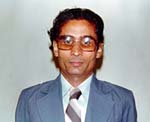
|

|
|
|
|
||
|
Commentary Capital Buzz The Rediff Poll Crystal Ball Click Here The Rediff Special Arena |
Kemp was talking about Clarke's 'orbital towers', a grand vision of a city tethered to Earth, 36,000 km up from the equator, at a height where most of our communications satellites orbit. Now Rawal had already calculated that the maximum height of any structure, man-made or natural, cannot exceed 10 km on Earth. Or say 12 for a superior material in the third millennium. This was published in Science Age's January 1986 issue under the heading How high can a mountain be? Confident of his 10 km limit, Rawal denounced Clarke's 36,000 km towers, assuming the "four cylindrical towers" he had read of in the review to be resting on the Earth's surface, not tethered in space by a hyper-strong network of cables.
However, Rediff On The Net immediately got in touch with Clarke and hell broke loose. Clarke would have taken the situation in a kinder spirit had Rawal not told Rediff that the book was not science fiction but an "outlandish fantasy". His colleague, Nehru Science Centre Director (Publications) P K Ravindranath went a step ahead, saying "A science fiction writer must remain within the limits of science and nature. It is here where Clarke has tripped." Rawal was emphatic that to accept the possibility of such structures is "like believing that matter can travel faster than light". On Thursday, May 8, over the phone from Colombo, Clarke told Rediff "I wish the man (Rawal) would not make a fool of himself in public like this. I have communicated with a Nobel Prize winning scientist who has given me specifications of the new material (to build the 36,000 km 'orbital towers')." Hours later Rediff had him panting over the phone lines, just back from a table-tennis game. His fury had not abated: "I think Dr Rawal is really leading with his chin here." That very night there was an e-mail from the legend. "Poor Dr Rawal! You should give him a chance of withdrawing his letter. Even his calculations for the height of a standing tower is wrong - it is 40 km (with carbon composite), not 10 or 12. But this is totally irrelevant to the 'orbital tower' which now has an enormous technical literature covering the last quarter century… Suffice to say that the two recent Nobel winners (chemistry), Smalley and Kroto, have both complimented me for my accurate prediction of the material - C60 - that will make the tower possible - and which has three times the tensile strength necessary!" When confronted with such a formidable defence, Rawal agreed to have erred in relying on just a newspaper report and, on Rediff's insistence, has agreed to go to the press once again, this time to clear up the mess. However, Rawal still had some points to make. He is "very doubtful" that geostationary satellites would be able to hold the weight of 36,000 kilometres of supporting cables. He is also cross with the choice of the word 'tower', which, he says misled him in the first place. And finally, Rawal does stick by his 10-12 km limit for the height of a structure resting on the surface of the Earth despite Clarke's carbon composite solution.
Even as the Rediff scribes were busy trying to get through to Rawal with the bad news, a United States Air Force's aerospace engineer, Jerome Pearson, dropped another e-mail after hearing of the controversy from Clarke himself. Pearson said "The space elevator was dubbed a 36,000-km-high 'building' by Dr Rawal, and that phrase shows he is thinking about a structure built from the ground up, and in compression. Buckling will then limit its height, as well as the material strength. If it were just a matter of material strength, a tower scores of kilometres high could be built of existing composites such as graphite epoxy or PBO. Buckling can also be handled by pressurising and tapering the tower. See the paper by Dr Geoffgey A Landis and Craig Cafarelli presented at the 46th IAF Congress, Oslo, Norway, AIAA paper IAF-95-V.4.07. It was titled Tsiolkovsky's tower revisited and discuss pressurised composite towers hundreds of kilometers tall. He continued that "However, the space elevator to geostationary orbit, 36,000 km high, is not a tower in compression; it is a cable in tension. Such a cable can be hung to any length without buckling; the length is limited by the strength-to-density ratio, which I called the 'characteristic height'. Any material can be built into a tower to this height without being tapered. However, if it is tapered exponentially as a function of the length for a constant stress, then the height is limited only by the taper ratio from top to bottom. A tapered hanging cable from geostationary orbit to the earth could be built with graphite epoxy with a taper of 'e' to the 10th , and with carbon nanotubes, based on the theoretical strength of buckminsterfullerene, with a taper ratio of only the order of 10. The space elevator must extend beyond geostationary altitude, of course, for balance. It would be capped with a counterweight to put the entire structure in tension and be able to lift payloads into orbit." "See my article in Acta Astronautica for September/October 1975, which introduced the idea of the space elevator to the spaceflight community. Once you understand that it is not a 'building', but a cable in tension, I believe your reservations will be put to rest (at least theoretically)," he concluded. Tell us what you think of this report
The Rediff Special
|
| ||||||

|
Home | News | Business | Cricket | Movies | Chat
Travel | Life/Style | Freedom | Infotech
All rights reserved

